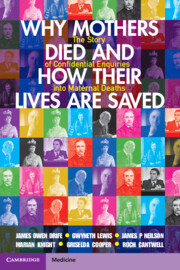 Why Mothers Died and How their Lives are Saved
Why Mothers Died and How their Lives are Saved Published online by Cambridge University Press: 05 April 2023
In the 1900s infant mortality was appalling, and it was the highest in the working class in the north of England. A national association for its prevention was formed and official enquiries were initiated. Concern about maternal mortality began during the Great War. In 1919 George Newman, head of the new Ministry of Health, appointed an all-female team to investigate, headed by Janet Campbell. In 1923 she made wide-ranging recommendations on training, clinical practice and provision of maternity beds. Every maternal death was to be investigated by the local medical officer of health. Pressure for parliamentary action came from the Queen and other leading women who had had difficult labours. An enquiry had taken place in Scotland and in 1928 an English national enquiry was organised. Case reports were collated by Arnold Walker and Joe Wrigley, obstetricians known for their common sense. Its 1932 Report covered 5,805 deaths and recommended that enquiries should continue. At the same time Dr Andrew Topping, medical officer in Rochdale, involved local communities in improving maternity care. Rochdale’s maternal mortality rate, the highest in England, was halved within two years.
To save this book to your Kindle, first ensure [email protected] is added to your Approved Personal Document E-mail List under your Personal Document Settings on the Manage Your Content and Devices page of your Amazon account. Then enter the ‘name’ part of your Kindle email address below. Find out more about saving to your Kindle.
Note you can select to save to either the @free.kindle.com or @kindle.com variations. ‘@free.kindle.com’ emails are free but can only be saved to your device when it is connected to wi-fi. ‘@kindle.com’ emails can be delivered even when you are not connected to wi-fi, but note that service fees apply.
Find out more about the Kindle Personal Document Service.
To save content items to your account, please confirm that you agree to abide by our usage policies. If this is the first time you use this feature, you will be asked to authorise Cambridge Core to connect with your account. Find out more about saving content to Dropbox.
To save content items to your account, please confirm that you agree to abide by our usage policies. If this is the first time you use this feature, you will be asked to authorise Cambridge Core to connect with your account. Find out more about saving content to Google Drive.